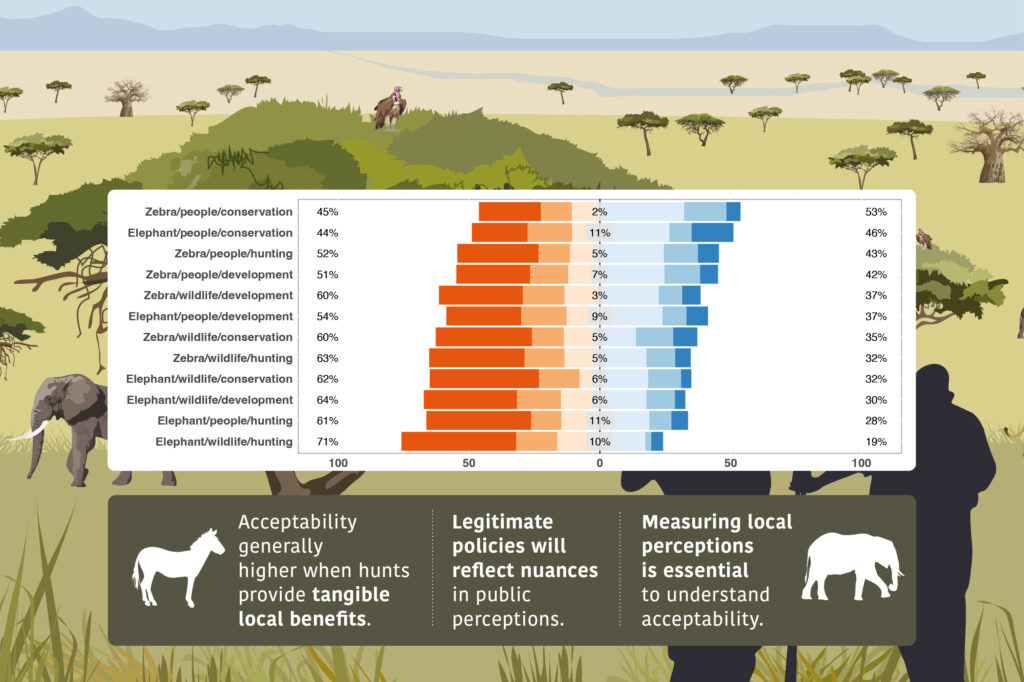Exploring the social acceptability of trophy hunting
February 16, 2024Fierce international debates rage over whether trophy hunting is socially acceptable, especially when people from the Global North hunt well-known animals in sub-Saharan Africa. But how much do we really know about how acceptable or unacceptable members of the public perceive trophy hunting to be? And are some forms of hunting less acceptable or more acceptable than others?

A new paper led by WildCRU’s Morally Contested Conservation (MCC) project investigates perceptions of the acceptability of trophy hunting in sub-Saharan Africa among more than 1200 people who live in urban areas of the United States, United Kingdom, and South Africa.
The team used an online experiment to evaluate whether acceptability of trophy hunting depends on what animal would be hunted, and how meat and revenue from the hunt would be used. Each participant in the experiment was asked how acceptable or unacceptable it would be for a particular hunt to take place. Some involved hunting elephants, others hunting zebras. In some, meat would be left for wild animals to eat but in others meat would be provided to people who live nearby. In some, revenues would help support wildlife conservation locally, in others revenues would help support economic development locally, and in others revenues would help support hunting enterprises.
This approach allowed the team to understand why some hunts were perceived as more or less acceptable than others. Overall, zebra hunting was more acceptable than elephant hunting, providing meat to local people more acceptable than leaving it for wildlife to eat, and revenue supporting wildlife conservation more acceptable than supporting economic development or hunting enterprises. Acceptability was generally lower among participants from the United Kingdom and those who more strongly identified as an animal protectionist, but generally higher among participants with more formal education, who more strongly identified as a hunter, or who would more strongly prioritise people over wild animals.
Overall, participants perceived hunts to be more acceptable when they would produce tangible benefits for people who live in or near hunting areas in sub-Saharan Africa. The study therefore provides evidence that public perceptions are more pragmatic than is often evident in media coverage and social media exchanges that leave little room for context and nuance. This underscores the importance of recognising that ‘trophy hunting’ is a broad term that covers a wide range of activities involving many different species, motivations, and ecological and economic impacts.
The research team proposes that their findings could help inform contemporary decisions over the role of trophy hunting in wildlife management and economic development. These include decisions in African countries on whether to continue, reform, or establish hunting operations as well as decisions on potential trophy import restrictions in North America and Europe. For example, “smart bans” allowing imports from hunts that clearly demonstrate local benefits might better reflect nuances in perceptions of people who do not live in or around hunting areas in sub-Saharan Africa, while incentivising good practice among hunting operators.
The team emphasise that it will be especially important to understand perspectives of trophy hunting among people who live in rural areas of sub-Saharan Africa, who are most affected by decisions affecting wildlife in the region.
Hunting, including trophy hunting, is one of the controversial issues in conservation that the MCC team study in rural communities in Kenya, Tanzania, and Zimbabwe.
The paper can be accessed here:
https://royalsocietypublishing.org/doi/10.1098/rspb.2023.1638